Related Research Articles
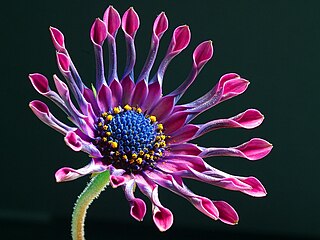
A cultivar is a type of plant that people have bred for desired traits, which are reproduced in each new generation by a method such as grafting, tissue culture, or carefully controlled seed production. Most cultivars arise from purposeful human manipulation, but some originate from wild plants that have distinctive characteristics. Cultivar names are chosen according to rules of the International Code of Nomenclature for Cultivated Plants (ICNCP), and not all cultivated plants qualify as cultivars. Horticulturists generally believe the word cultivar was coined as a term meaning "cultivated variety".

The lentil is an edible legume. It is an annual plant known for its lens-shaped seeds. It is about 40 cm (16 in) tall, and the seeds grow in pods, usually with two seeds in each. As a food crop, the majority of world production comes from Canada (33%) and India (25%), producing 58% combined of the world total.

Vicia faba, also known in the culinary sense as the broad bean, fava bean, or faba bean, is a species of vetch, a flowering plant in the pea and bean family Fabaceae. It is widely cultivated as a crop for human consumption, and also as a cover crop. Varieties with smaller, harder seeds that are fed to horses or other animals are called field bean, tic bean or tick bean. Horse bean, Vicia faba var. equinaPers., is a variety recognized as an accepted name. This legume is very common in Southern European, Northern European, East Asian, Latin American and North African cuisines.

Wild rice, also called Canada rice, Indian rice, or water oats, is any of four species of grasses that form the genus Zizania, and the grain that can be harvested from them. The grain was historically gathered and eaten in both North America and China, but eaten less in China, where the plant's stem is used as a vegetable.
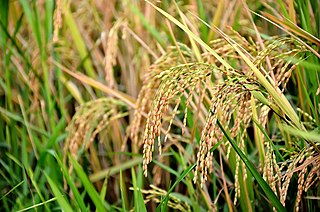
Oryza sativa, commonly known as Asian rice, is the plant species most commonly referred to in English as rice. It is the type of farmed rice whose cultivars are most common globally, and was first domesticated in the Yangtze River basin in China 13,500 to 8,200 years ago.
The founder crops are the eight plant species that were domesticated by early Neolithic farming communities in southwest Asia, which formed the basis of systematic agriculture in the Middle East, North Africa, India, Persia and Europe. They consist of three cereals, four pulses, and flax. These species were amongst the first domesticated plants in the world.

Foxtail millet, scientific name Setaria italica, is an annual grass grown for human food. It is the second-most widely planted species of millet, and the most grown millet species in Asia. The oldest evidence of foxtail millet cultivation was found along the ancient course of the Yellow River in Cishan, China, carbon dated to be from around 8,000 years before present. Foxtail millet has also been grown in India since antiquity.

Echinochloa crus-galli is a type of wild grass originating from tropical Asia that was formerly classified as a type of panicum grass. It is commonly known as cockspur, barnyard millet, Japanese millet, water grass, common barnyard grass, or simply "barnyard grass". This plant can grow to 60" in height and has long, flat leaves which are often purplish at the base. Most stems are upright, but some will spread out over the ground. Stems are flattened at the base. The seed heads are a distinctive feature, often purplish, with large millet-like seeds in crowded spikelets.

Berberis vulgaris, also known as common barberry, European barberry or simply barberry, is a shrub in the genus Berberis. It produces edible but sharply acidic berries, which people in many countries eat as a tart and refreshing fruit.
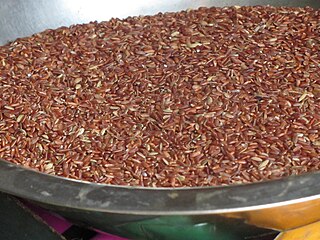
Red rice is a variety of rice that is colored red by its anthocyanin content. It is usually eaten unpolished or partially polished, and has a red bran layer, rather than the more common pale brown. Red rice has a nutty flavor. It has the highest nutritional value among rices eaten with the bran intact.. Some red rice has a low glycemic index. The rice will be slowly digested and energy will be slowly released. This will cause a slower increase in blood sugar levels. Red rice contains high antioxidant levels that reduce free radicals in the organism. It is also a richer source of iron, magnesium, calcium and zinc than white rice.

Pandanus amaryllifolius is a tropical plant in the Pandanus (screwpine) genus, which is commonly known as pandan. It has fragrant leaves which are used widely for flavouring in the cuisines of Southeast Asia and South Asia.
Weedy rice, also known as red rice, is a variety of rice (Oryza) that produces far fewer grains per plant than cultivated rice and is therefore considered a pest. The name "weedy rice" is used for all types and variations of rice which show some characteristic features of cultivated rice and grow as weeds in commercial rice fields. Populations of weedy rice are found in many rice-growing regions. Weedy rice varieties generally have fragile stalks that self-seed before harvest. Variations of weedy rice adapt to a wide range of natural conditions.

Camargue red rice is a variety of red rice cultivated in the wetlands of the Camargue region of southern France.
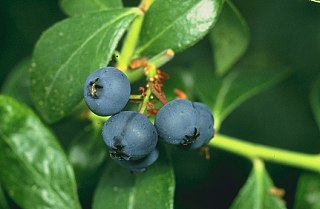
Blueberries are a widely distributed and widespread group of perennial flowering plants with blue or purple berries. They are classified in the section Cyanococcus within the genus Vaccinium. Vaccinium also includes cranberries, bilberries, huckleberries and Madeira blueberries. Commercial blueberries—both wild (lowbush) and cultivated (highbush)—are all native to North America. The highbush varieties were introduced into Europe during the 1930s.

The southeast Asian country of Laos, with a landmass of 23.68 million hectares, has at least 5 million hectares of land suitable for cultivation. Seventeen percent of this land area is actually cultivated, less than 4 percent of the total area.
Upland rice is rice grown on dry soil rather than flooded rice paddies.

Oryza glaberrima, commonly known as African rice, is one of the two domesticated rice species. It was first domesticated and grown in West Africa around 3,000 years ago. In agriculture, it has largely been replaced by higher-yielding Asian rice, and the number of varieties grown is declining. It still persists, making up an estimated 20% of rice grown in West Africa. It is now rarely sold in West African markets, having been replaced by Asian strains.
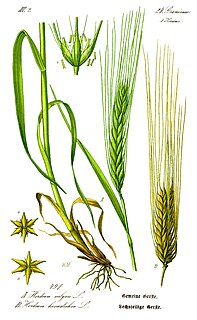
Barley, a member of the grass family, is a major cereal grain grown in temperate climates globally. It was one of the first cultivated grains, particularly in Eurasia as early as 10,000 years ago. Globally 70% of barley production is used as animal fodder, while 30% as a source of fermentable material for beer and certain distilled beverages, and as a component of various foods. It is used in soups and stews, and in barley bread of various cultures. Barley grains are commonly made into malt in a traditional and ancient method of preparation.

A center of origin is a geographical area where a group of organisms, either domesticated or wild, first developed its distinctive properties. They are also considered centers of diversity. Centers of origin were first identified in 1924 by Nikolai Vavilov.

Rice production in China is the world's largest producer of rice, making up 30% of global rice production, making up an important part of the national economy. It produces the highest rice yields in Asia, at 6.5 metric tons per hectare. Rice is produced throughout the nation and is believed to have been domesticated around the Yangtze River Valley and Yellow River from 7000 BC. The main variants of rice grown in China are indica and japonica subspecies, with ongoing developments in hybrid rice. Rice cultivation is labour-intensive, and is dependent on a variety of cropping and planting methods, as well as fertiliser and pesticides. Rice is highly prized by consumers as a food grain, making it a staple food for two-thirds of the nation.